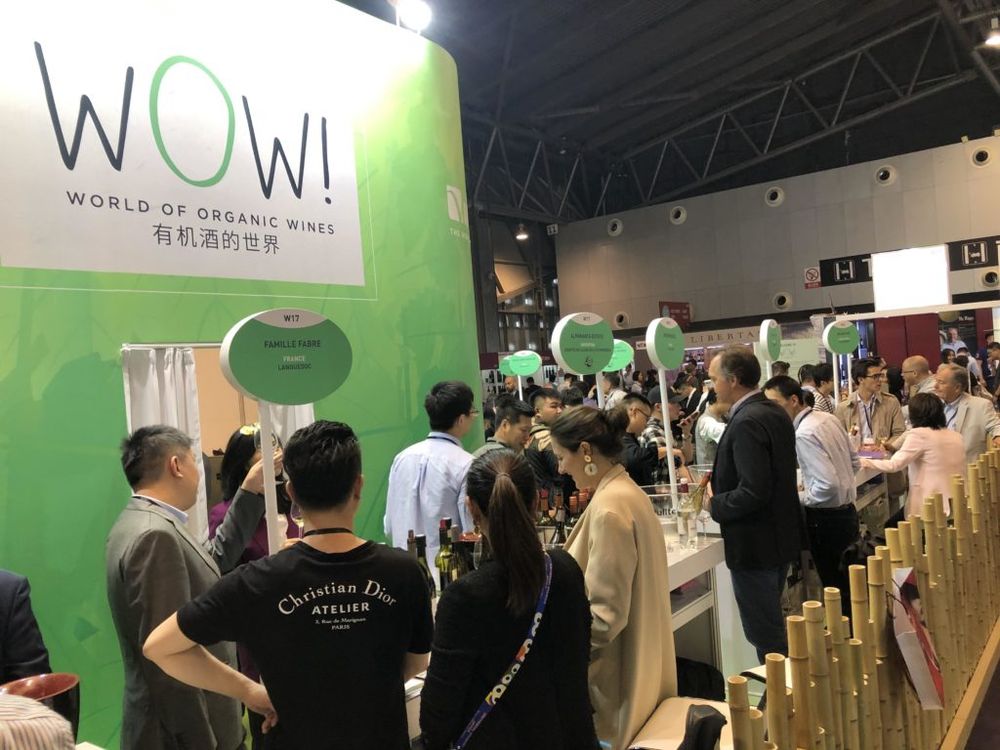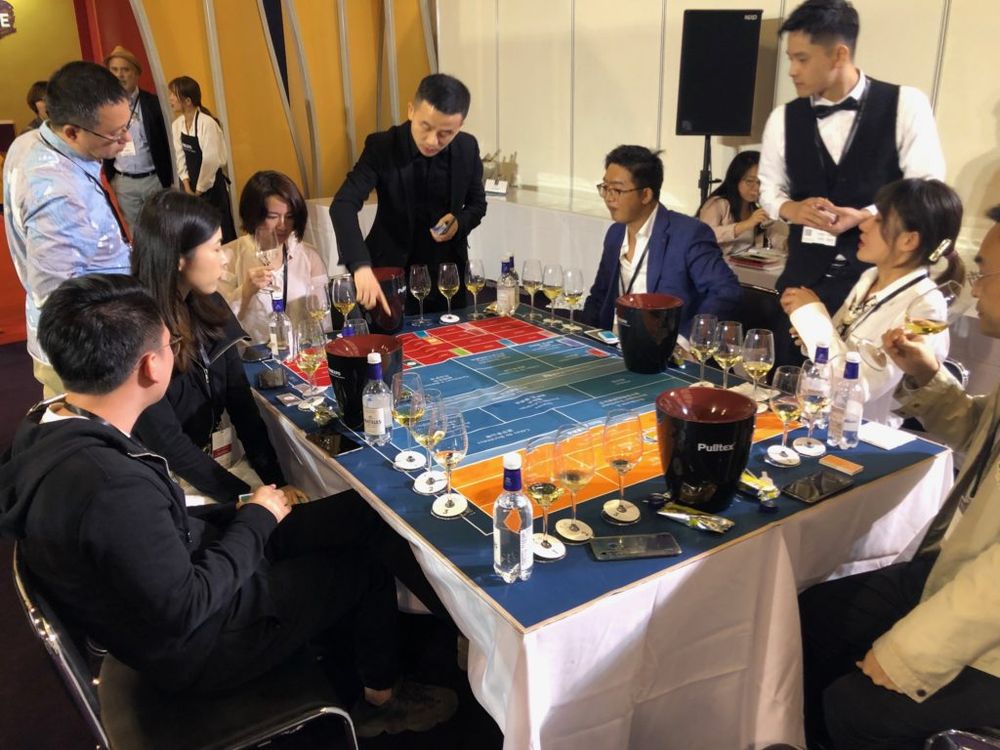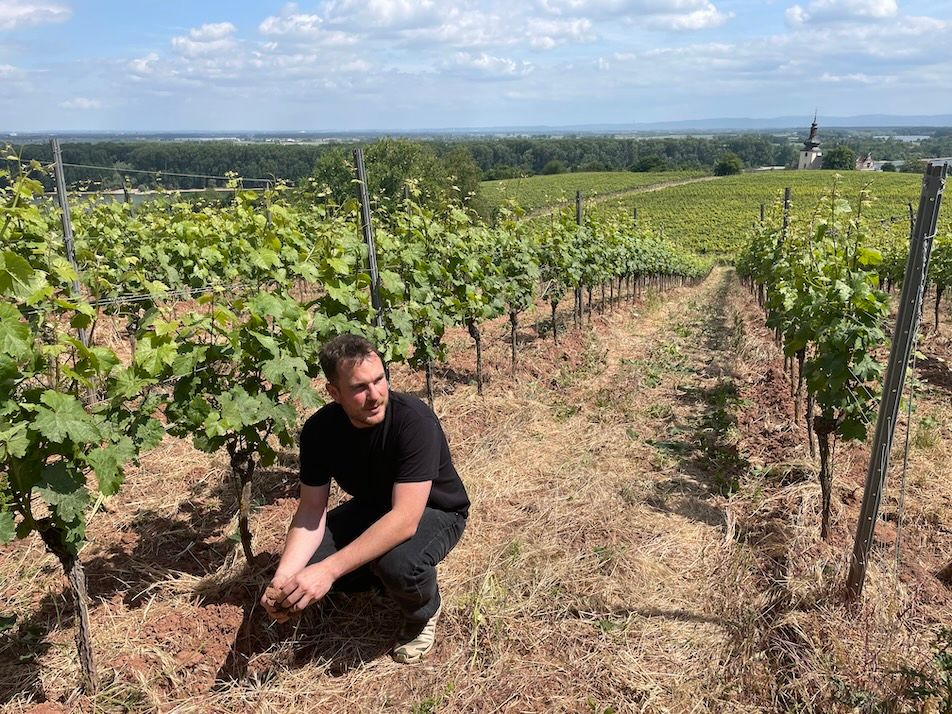This week ProWein is following Vinexpo in hosting a major wine trade fair in Shanghai. For a market that is supposed to be going through a downturn there is still plenty of business to be done right across China as importers and producers find ever more effective ways to work with each other.
It’s one thing writing about what is going on in a particular country’s wine industry from afar, it is quite another to go and experience and see it for yourself. Particularly one as fast changing, and moving as China.
So perhaps I should have been more prepared for what to expect on my visit last week’s to what was Vinexpo’s first trade exhibition in Shanghai. Particularly as the last time I had been in the city, Bill Clinton was just being inaugurated into the White House in January 1993.

The sky scrapers on the left back did not exist in 1993. Such has been the pace of change in China
But where else in the world can you go and find a city that has effectively built its double on the other side of the river. Which is, in effect, what Shanghai has done over the course of the last 26 years. It was quite something to look out from the city’s famous Bund, where I have a photograph of myself with nothing but river and marsh land behind me, to see it replaced by a landscape of sky scrapers as far as you can see.
It’s only then do you really start to appreciate just how far and how fast China has changed in the last 20 plus years. For the wine industry those changes have been fast forwarded and squeezed into largely the last 10 years, such has been the pace in which wine has made more than just a foothold in the country.
Yes, average per capita wine consumption is still very low at 1.2 litres compared to mature wine producing countries such as France at around 45 litres per person. But the sheer number of people means China is now the third biggest wine market in the world, worth $16.5 billion, just behind France on $16.7bn (Vinexpo/IWSR figures).
Growing fast
China is a wine country in a hurry. OK, figures for this year might reflect a slow down in growth, particularly amongst imported wine, down 20% in value and 12% in volume for the first six months of the year, with France particularly badly hit with a 40% drop in value sales. But for those on the ground this is just a blip, a distraction from China’s sheer momentum to push forward, taking all those prepared to jump on the ride with them.
Ian Ford, one of the sharpest and most influential commentators on the Chinese wine market, thanks to his 20 plus years working there, first with the Summergate import business, and now the Asian brand consultancy, Nimbility, is still supremely confident that the overall Chinese market will double in size to at least 120m 9 litre bottles versus 60m 9 litre bottles now within the next 10 years.

This was the first time that Vinexpo had held a show on mainland China but has had great success with its longstanding Hong Kong show
Just look at Australia that has now replaced France as the number one imported wine country. Whilst other countries saw their value shares slump it saw an 18% jump in value of its exports to China/Hong Kong and Macau between October 2018 and September 2019 to A$1.2bn, compared to the A$436m it sends to the US and A$365m to the UK (Wine Australia).
The feeling that this is still a country very much on the up was the overwhelming feeling you took from last month’s Vinexpo Shanghai, which by its own admission, was a small, compact, what it calls “niche” event you would expect from a first time show. There was, though, such a feeling of genuine energy, excitement and buzz in the room, particularly on the event’s first two days, that more established events could only dream of.
These were serious visitors on a mission to find, discover, taste, and most of all buy and order wine, then and there. They were also noticeably far younger than you would expect from a trade show in Europe or the US. Those of us aged over 40, never mind 50, felt a little out of place.

The enthusiasm of the buyers and visitors to Vinexpo Shanghai made it an exciting and invigorating event to be part of
Right place to be
That feeling of excitement and momentum was also shared by the producers that had come to support and make the most of Vinexpo’s first Chinese event. In all there were 260 exhibitors present, covering 19 countries and 40 different regions, predominantly from France, but with good contingents also from South Africa and Italy amongst others. The WOW! stand for organic wines was, in particular, a real hive of energy and enthusiasm.
Andrej Razumovsky, founder of Alpamanta, one of the first skin contact, natural winemakers in Argentina, was there looking for an importer and, if anything, looked a bit overwhelmed by the sheer number of people he had met and the options he had to choose from.
“We have seen such professional people from all over China, but also Japan and Korea. It’s been amazing for us. Everyone is so enthusiastic. People are also very knowledgeable about what they are looking for. We’ve had a really good level of conversation,” he said.

The organics stand in particular was extremely popular amongst Chinese visitors
There was certainly encouragement for producers both big, small, and independent to make their way in China. Mario Aron, chief executive, of import business, Sarment, said: “There is a good opportunity now here for more niche brands. People are increasingly interested in new, and different wines to the usual suspects that have been in the market. This is such a developing market.”
He added: “There might have been a temporary reduction in imports, but consumption levels have not changed. What is key is the kind of products you are looking to introduce here. You need to find your niche and approach it in the right way. But there are definitely opportunities for more medium sized producers who have the right strategy.”
Vinexpo’s meeting system where producers and importers can be married up before the event based on their buying and selling needs was a real hit at Vinexpo Shanghai. Christine Andrews, Asia and Australia manager of Journeys End in South Africa said it had proved very successful for them, and why it is so keen to support the show. “At Vinexpo Hong Kong it was amazing and we had meeting for the three days of the show, so it was good to be able to do that here as well,” she said.
It’s also Journeys End close relationship with its Asian importer, Links Concept, that has really helped make a difference, she said. “They are on the same page as us.”
Importers in flux
China may have seen a cull of wine importers during 2019 – down by 34% or over 2,000 in some estimates, in the first half of this year alone – due, in part, to the country’s economic slowdown and weaker currency, but that does not mean there are not plenty of others keen and anxious to do business. Which was certainly the case at Vinexpo Shanghai where those producers more experienced in working with China said it was important to take your time and not be bowled over by the first large order you receive.
Which must be easier said then done. Particularly when you have an importer willing to buy 50,000 bottles there and then of your wine with a quick scan on his smartphone, which is what I overhead one South African producer being asked to do.
As Marcus Ford, the Asia and China manager for Wines of South Africa, stressed: “It is very easy to import wine into China. It’s so much harder to sell it.”

Ian Ford of Nimbility leads a debate with Concha y Toro’s and of Mario Aron Sarment on future of Chinese wine market
In fact the big slump in the number of importers during the downturn 2019 is less dramatic than it sounds considering the number of small players in the market, which could be businesses in other sectors buying wine to give to clients, to individuals who see wine buying as more of a hobby than a serious business concern, added Ford. Particularly when it can take at least 270 days for an importer to be paid.
For producers China has to be all about the long term, stressed WOSA’s Ford. “The key to China is your strategy and being absolutely clear about what you want to do here. Either way it takes a lot of work and time building long term relationships and a community for your wine,” he explained. “The producers from South Africa who have done well in China all comes down to how much time they have spent here.”
Like Distell which has one of the power brands for imported wine in the country – Two Oceans. Naas Erasmus, commercial director, agreed it is all about having the “right commercial strategy” for each brand. He hopes its long term commitment in the country will eventually help Distell take up 15-20% of the South African share in the market. “We’ve been here for some time and have much more of a specific focus between what Two Oceans can do and where we work with wines like Fleur du Cap and Durbanville Hills. There’s more alignment of what we are doing.”
But he also recognises that even a company of the stature of Distell can’t do it alone, it needs the support of the rest of the South African industry. “We need to work together more in China if we are going to get the category going more.”
Exciting market
“It’s such an exciting market to be in,” added Marcus Ford. “Remember GDP is still growing at 6-8% and the number of people who will economically be viable to drink wine will go up all the time. So those who take China seriously now will have the time to grow with that market. You also have to remember it is still a very young import market. Only 10 years old. As people’s taste change they will be looking for new wines and new stories. But you need to be committed to come here at least two times a year.”

Gemtree’s Mike Brown from Australia is so committed to China he does not even have an importer but prefers to do the work himself
Then there is Mike Brown of Gemtree wines from McLaren Vale in Australia who sees such an opportunity in China for his range of organic wines that he does not even have an importer, but instead is in the market at least five times a year and sells direct “by finding the right partner in each major city who then sell to their contacts”. So a far more B2C model. “We don’t do the normal trade routes. We have a point of difference being organic and biodynamic so if we find the right business business they can then sell our wines direct to their customer base,” explained Brown.
He is even looking at setting up his own bonded warehouse in China so that he can wine in the market within 36 hours of an order being made. “Things are moving so quickly in China,” he added.
Natalie Potts, China area manager for New Zealand Winegrowers, said customers and and buyers are far more open to try different styles of wines from New Zealand than they are in more mature, and what you might call entrenched markets like the UK. That also carries through to the tastings and buzz there is in the trade and with consumers to explore different aspects out of New Zealand outside of Sauvignon Blanc and Pinot Noir and host more ambitious events.
“We have a very good relationship with the trade here. There are a lot of key opinion formers here in Shanghai,” she said.
Part of that relationship has been identifying the right buyers, sommeliers and writers to go and visit New Zealand and really help “shift the dial’ about the country by allowing them to go and “experience it,” she added. “We have less than 1% market share here, but we have a lot more than 1%” when it comes to making a noise about its wines, claimed Potts
A revelation
As a newcomer to the Chinese wine scene it was a revelation to watch the intensity of the buyers as they moved quickly from stand to stand, tasting, snapping pictures and sending messages and updates via Wechat.

Just another way they do things differently in China. Turning wine education into a part gambling game
Many were particularly intrigued to know why I was there, asking producers questions about their export strategies to China and experiences of working in the country. So much so that they would stop tasting, listen in, and then chip in with answers of their own. Quite happy to openly talk about what they were looking for, and how much of a particular wine they wanted to buy at what price. Details you would never hear buyers in Europe and other markets openly discuss with producers, never mind eavesdropping journalists.
It was great to feel actually part of the show. Refreshing, exciting and very different.
We have a tendency in business – and the media – to want to pigeon hole, and summarise the objectives and opportunities in growing countries like China. But based on my first experience that would be a mistake. This is clearly a country in flux, going through huge structural changes, and re-alignments after such an explosion in growth.
Mario Aron at Sarment summed it up particularly welly when he urged the trade not to look at China as one market, but a whole series of provinces and mini-markets, each with their own opportunities and challenges. Not too dissimilar to the complexities of the three-tier system in the US.
Yes, 2019 may be the most challenging that key players such as Ian Ford, and Rodrigo Jackson, managing director of Concha y Toro, Central Asia, have found in their respective careers working in the country. That should not, however, take away from not just the huge potential that clearly China has, but the sheer magnetic exuberance, passion and interest the people working in this exciting market have for making wine happen in China.
- In the second part of our report from Shanghai The Buyer will look at different strategies and routes to market that producers can look to take.
- This is an extended and expanded version of one first published on VINEX, the online bulk and bottle trading site.









































